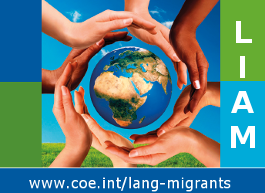Raising intercultural awareness
On arrival in the country where they will be settling and in which they may have to live permanently, migrants discover a new social environment. Through these migrants, the members of the host societies discover a new form of otherness, quite distinct from the differences they are familiar with in their own cultural space (regional, social, linguistic, behavioural, lifestyle and other types of difference). The encounter is therefore asymmetrical because migrants are forced to adapt to a new living environment, whereas the residents of the host country only have to make room for this new form of diversity. However, accepting diversity is a two-way process, and is vital for social cohesion.
This form of intercultural encounter is not as straightforward as it might seem, because it can cause superficial misunderstandings, and in particular can trigger ethno-centric reactions of automatic rejection. Educational measures that take account of this phenomenon should therefore be introduced. In order to foster acceptance of individuals from different cultures, schools must prepare all children, from nursery-school level onwards, for such acceptance. This requires intercultural education, a training mechanism which is geared to developing, via the teaching of languages and other subjects, open, proactive, reflexive and critical attitudes in order to learn to positively apprehend and profitably manage all forms of contact with otherness. Intercultural education is designed to develop curiosity for discovery and personal, attentive and benevolent management of cultural diversity, because it strives to mitigate ego- and ethno-centric attitudes. It must be based on a plural, dynamic conception of cultural and social identity.
For adult migrants undergoing training, awareness of cultural differences and their raisons d’être can be created in a reasoned manner on the basis of verbal reactions prompted by contact (during language classes) with the characteristics of the host society considered as strange or shocking vis-à-vis certain deep-seated convictions. Such activities are geared to moving learners on from spontaneous, often emotional, reactions to controlled, thoughtful ones, with a view to complexifying representations. To this end, we might propose activities to create awareness of society, from the angle of sociological and anthropological orientation, in order to provide necessary items of knowledge, develop non-naïve interpretative competences and elicit discourse in reaction to these experiences, which will be the subject of the educational work on the attitudes translated by this verbalisation process. Management of these verbal reactions should have the minimum aim of fostering linguistic goodwill, which is a prerequisite for democratic co-existence (see Byram, Gribkova et Starkey :
Developing the intercultural dimension in language teaching).
JCB
Related resources
- Developing the Intercultural Dimension in Language Teaching, 2002, Byram, Gribkova, Starkey, Council of Europe
EN FR
- White Paper on Intercultural dialogue "Living Together As Equals in Dignity", 2008, Council of Europe.
EN FR
- Final Report to the Committee of Ministers, 1998, Committee of Wise Persons.
EN FR



